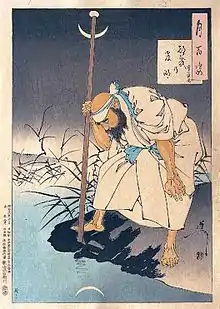Hōzōin-ryū
Hōzōin-ryū (宝蔵院流) is a traditional school (koryū) of Japanese martial arts that specializes in the art of spearmanship (sōjutsu). Hōzōin-ryū was founded by Hōzōin Kakuzenbō In'ei (宝蔵院 覚禅房 胤栄, 1521–1607) in c. 1560.[1] In'ei was a Buddhist monk of Kōfuku-ji Temple in Nara, Japan.[2] He adored martial arts and trained in the art of swordsmanship. At the same time, he was coached and mentored by Daizendayū Moritada (大膳太夫盛忠), a master of the spear. Under this master's guidance, In'ei honed his spearmanship.[3]
| Hōzōin-ryū (宝蔵院流) | |
|---|---|
| Ko-ryū | |
 In'ei watching the reflection of the moon. | |
| Foundation | |
| Founder | Hōzōin Kakuzenbō In'ei (宝蔵院 覚禅房 胤栄, 1521–1607) |
| Date founded | c.1560 |
| Period founded | Sengoku period (mid-15th century–mid-17th century) |
| Location founded | Nara, Yamato Province |
| Current information | |
| Current headmaster | Ichiya Junzō |
| Current headquarters | Nara, Nara |
| Arts taught | |
| Art | Description |
| Sōjutsu | Spear art |
| Descendant schools | |
| Daitō-ryū Aiki-jūjutsu • Shindō Yōshin-ryū | |
It is said that one evening, on seeing the reflection of the crescent moon shining on Sarusawa pond, he was inspired to create a spear with a cross-shaped spearhead.[2] He imagined this style of spear would be more effective in fighting. With this new type of spear (known as jumonji-yari (十文字槍)), he founded the Hōzōin-ryū.
Later, the teachings Hōzōin-ryū sōjutsu were passed down to other Buddhist monks of his order, including Hōzōin Inshun (1589-1648), Hōzōin Insei (1624-1689), Hōzōin Infū (1682-1731), Hōzōin Inken (1746-1808),[3] Nakamura Naomasa and then Takada Matabei Yoshitsugu. The three best disciples of Takada went to Edo, present day Tokyo, to promote the art. Its reputation spread nationwide and the number of disciples increased. As martial art of Hōzōin-ryū sōjutsu was passed down from generation to generation, various new techniques as well as new dojo were created.[4]
At the end of the Tokugawa shogunate, (around the middle of the 19th century) there were many masters of Hōzōin-ryū sōjutsu employed at the shogunate's martial arts training center. In the 19th century, the school was revived and updated thanks to Takeda Sokaku.[5][6]
Eventually in 1976, Hōzōin-ryū sōjutsu returned to Nara. In 1991 Kagita Chubei (鍵田 忠兵衛)[4] was appointed the 20th headmaster and has been leading the Hōzōin-ryū sōjutsu school until his death on 16 December 2011. His successor and 21st headmaster is Junzo Ichiya (一箭 順三).[7]
An ancient Japanese poem expresses the spear of Hōzōin-ryū sōjutsu:
"It can be a spear to thrust. It can be a naginata to cleave. It can be a Kama to slash. In any case, it never fails to hit the target."
External links
References
- "Hozoin-ryu Takada-ha".
- "宝蔵院流槍術". www4.kcn.ne.jp. Retrieved 2020-05-04.
- Habersetzer, Gabrielle. (2000). Encyclopédie technique, historique, biographique et culturelle des arts martiaux de l'Extrême-Orient (in French). Habersetzer, Roland, 1942-, Centre de recherche Budo. Paris: Editions Amphora. p. 220. ISBN 2-85180-556-8. OCLC 45361964.
- "The History of the Hozoin-Ryu Sojutsu". www4.kcn.ne.jp. Retrieved 2020-05-04.
- "Daito-ryu Aikijujutsu Headquarters / History / Takeda Sokaku". www.daito-ryu.org. Retrieved 2020-05-04.
- "Takeda Sōkaku". Northern Virginia Sin Moo Hapkido Institute. Archived from the original on 2014-03-06.
- "Hozoin-Ryu Spearmen". www4.kcn.ne.jp. Retrieved 2020-05-04.